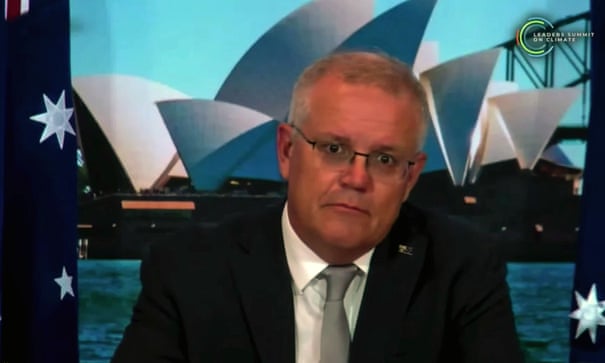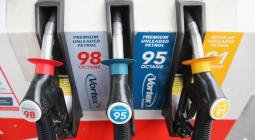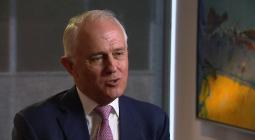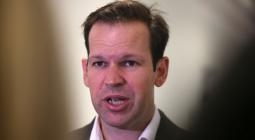Global reset on climate action leaves Scott Morrison looking like yesterday’s man

At Joe Biden’s virtual summit, achieving net zero by 2050 was considered a given, not something you might do, possibly, if Matt Canavan lets you.
While Australians slept on Thursday night, an extraordinary dynamic played out at Joe Biden’s climate crisis summit.
Many leaders (Germany’s Angela Merkel most directly) expressed relief that the United States was back in the business of global climate leadership after the wasteland of the Trump era, and countries formed an orderly queue to reward their Washington rescuers with significant emissions reduction pledges in the near term.
As we clicked past midnight Australian eastern time on Thursday night, summit watchers witnessed a brisk competition between nations for the most ambitious emissions reduction pledges. Climate policy is a wearying slog, so this felt like momentum. It felt like hope.
In bowling up higher targets for the 2030s, countries were committing to take action now, in this decade. At Biden’s event, achieving net zero by 2050 was considered a given, not something you might do, possibly, if Matt Canavan lets you.
Obviously saying isn’t doing. Ambitious targets need to be underpinned by policies that deliver the required action, otherwise it’s just politics.
But what the summit demonstrated is the world has reset on climate action, and will probably remain in a cycle of ambition while Biden is in the White House. Instead of a competition for who can avoid responsibility most cunningly, what’s under way now is a race to win the transition.
Australia needs to be in this race for the following reasons.
Runaway global heating imperils human lives. Failing to transition Australia’s carbon-intensive economy to the new energy economy imperils jobs, prosperity and opportunity. Australia, the resources economy, the exporter of carbon emissions, is now trading in a net zero environment. That die is cast. If the Coalition continues to dish up a fast food diet of weaponised climate politics and prolonged policy uncertainty – mobile capital looking to prosper in the transition will shift elsewhere, where the rules are clearer.
That’s our reality. That’s what the facts tell us.
But Scott Morrison turned up at Biden’s summit looking like yesterday’s man, out of step with his peers both in tone and substance.
Australia’s prime minister claimed we were doing sensationally at reducing emissions – a claim that was only truth adjacent if you excised the main driver of emissions growth, Australia’s liquefied natural gas (LNG) export industry.
Seriously. Some bright spark in the government apparently thought it was a good idea for Morrison to step into a virtual room of his global peers, aided by battle-hardened climate policy advisers with deep expertise, and bowl up an alternative fact.
Because 36% sounds better than 19%. Like Biden and John Kerry might be idiots.
(For the record, two-thirds of Australia’s 19% reduction happened before Tony Abbott won the 2013 election with his “carbon tax” hyperbole, which included a prediction that Whyalla would be wiped off the map.)
Morrison also told his peers that Australia’s commitments on targets were “bankable” – the clear inference being the climate ambition set might talk a big game but they don’t always deliver (which is a line the prime minister hammers at home).
This would be a reasonable debating point if one was third speaker for the negative at a Rotary debating tournament, but it was diplomatically discordant at an event where the host – Australia’s most important security ally – was hammering the importance of the world rising to the moment.
Targets aren’t always what they are cracked up to be presented like churlishness. Australia was so busy being defensive, so intent on puffing out our chest, and correcting the imagined poseurs of climate evangelism, that it failed to read the room.
In any case, the summit was just one point in time during a genuinely interesting week. Let’s step through the points of interest quickly.
The first thing to say is Morrison faced real pressure about climate action. The nub of the government’s discomfort was this: there was diplomatic pressure bearing down on Australia, and a summit to endure, but the prime minister wasn’t ready to telegraph any more ambition. Morrison has been trying to look less terrible on climate action since Biden won the presidential election. This is pretty obvious. But given the Coalition party room can be lethal, he can’t reposition too quickly.
While Morrison couldn’t shift on targets this week, there was a big movement elsewhere.

The prime minister began the week with a speech to the Business Council of Australia. This was a warm-up gig for the summit, and again there was a silly digression. Not a junk stat, like the concocted 36%, but red meat for the base. Morrison declared, in a room full of comfortably remunerated wine bar frequenters, that the transition to net zero would not be won in a wine bar – a penetrating insight if ever I’ve heard one.
The whine about the wine bar overshadowed a substantive and significant shift in government storytelling. The Coalition has been telling voters in the regions for more than a decade that climate action will steal their jobs and their four wheel drives and “wipe out” their towns.
This is the core of the Coalition’s cynical weaponisation of climate policy, the pitch that helped Morrison hold Queensland, and therefore government, in 2019.
But this week, suddenly, without warning, the transition to low emissions wasn’t an apocalypse. It was opportunity, and opportunity in exactly the same places the Coalition sold the apocalypse in 2019. The coming transition was a boon for Whyalla and Gladstone and the Pilbara, and a marginal seat on the Central Coast of New South Wales that may, or may not, depending on a process of grants allocations yet to be determined, become one of Australia’s new “hydrogen valleys” – like Silicon Valley, but with electrolysis.
This benign transition, the one that turned up this week, would preserve all jobs, and was “an exciting challenge” Australia would solve. Given that all the technological options the government is currently framing as champions of the “good” transition (hydrogen, carbon capture and storage) existed at the time of the 2019 election – it’s almost like one of the parties of government in Australia has been having a giant lend at our expense. Imagine that. Who knew?
Morrison is trying to limber the Coalition up to accept a net zero commitment by Cop26 in Glasgow in November. That’s where he wants to land, and he’s moving in increments.
Morrison consciously uncoupled from coal with the “gas led-recovery”. This week, he declared hydrogen “the new gas”. I’m not sure that we’ll ever get to wind or solar being the new gas – at least not before I’m pursuing my second career in floristry – but in any case, you see what he’s doing there: shape shifting, slogan by slogan.
Morrison gets lavish amounts of praise for this because the media complex is so used to the Coalition being unconscionable on climate change that anything two degrees south of terrible feels like progress. Some of my colleagues are willing to be stenographers to an epiphany, because God knows, we all want this to be real. Call this hope springs eternal, or possibly, accumulated trauma.
I’m a hard marker, and I like to be straight, so here’s my straight talk.
I know Morrison is on the move, but I don’t know whether this pivot is real or not, and I’m not intending to be lavish with praise unless there’s proof that it is deserved.
There is tangible proof we can look for. Here’s what an actual epiphany would look like: Australia joining much of the rest of the world in adopting science-adjacent medium-term emissions reduction targets, with policies that deliver real abatement. Starting now.
Over the past few months, Morrison has succeeded in training the eyes of Australia’s media on the government’s likely 2050 commitment at Cop26 in Glasgow because he backs himself to deliver that in some shape or form later in 2021.
But the main game is actually this decade. Governments know it. Central banks know it. Regulators know it. Corporations know it, and, increasingly, their future-focused shareholders. Investors controlling the trillions of dollars sloshing around global markets in search of bankable opportunity know it.
Morrison is hinting he’ll adjust the 2030 target, but this is more dangerous territory both internally and with the voters. It’s dangerous internally because emissions reductions now would be real, and history shows the Coalition can lose its mind when confronted by reality. It’s dangerous externally because five minutes ago the government told voters, hands on hearts, that ambitious action this decade would wreck the economy and steal their jobs. That’s quite a ship to turn.
Labor, battle-scarred by one apocalypse too many, is also hedging on action for the 2030s, not entirely sure whether or not they have washed up in a more favourable climate change reality post Trump, or whether they will be crushed in a redux of the same old election shit-fight in 2022, with new lies replacing old ones.
One thing is entirely clear.
The world isn’t waiting for Australia to get over itself.
The world is moving, and it’s past time we moved with it.
23 April 2021
The Guardian




